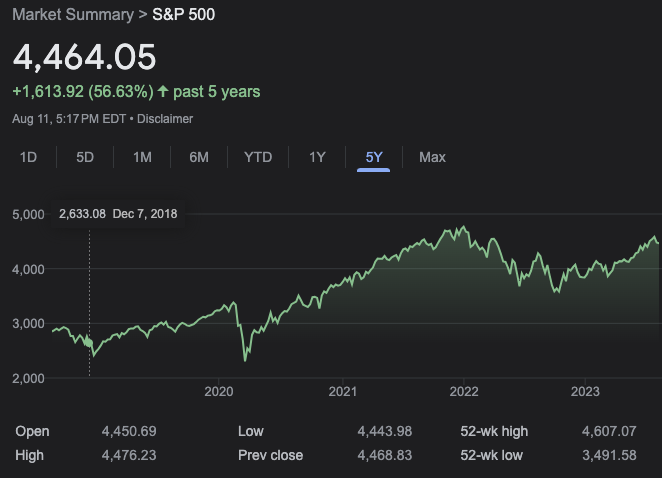Investing in the stock market has made millions of people millionaires.
Investing in the stock market can be a rewarding endeavor, offering the potential for long-term wealth growth and financial security. And it’s a great way to propel yourself along the wealth-building timeline faster than solely relying on your income.
However, for beginners, the stock market can also seem pretty darn complicated.
The good news is that with the right knowledge and approach, anyone can start their journey to becoming a successful investor.
This article is a comprehensive guide for beginners on how to enter the world of stock market investing.
Your Beginners Guide to the Stock Market
1. Understand the Basics
Before diving into the stock market, it’s crucial to build a solid foundation of knowledge. Understand what stocks are, how the stock market functions, and the key players involved.
Stocks represent ownership in a company, and when you buy a stock, you become a shareholder. The stock market is where these shares are bought and sold. Brokerages act as intermediaries, facilitating transactions between buyers and sellers.
So, what are stocks?
A stock, also known as a share or equity, represents ownership in a company. When you own a stock, you essentially own a portion of that company and become a shareholder.
Companies issue stocks as a way to raise capital for their operations and growth. Investors who purchase these stocks contribute funds to the company and, in return, gain ownership rights, potential dividends, and the ability to participate in the company’s decision-making processes through voting at shareholder meetings.
If the stock increases in value, the shareholders make money. Of course, this also means that shareholders lose money if the value of the stock goes down.
The value of a stock is influenced by various factors, including the company’s financial performance, industry trends, market sentiment, and broader economic conditions.
The longer you remain invested, the greater your chances of making money.
For instance, here is the S&P 500’s 5-year performance:

Notice the 1,600% increase in value!
To buy stocks, you need to follow a few steps.
- First, you’ll need to open a brokerage account. This can be done through traditional brokerage firms or online platforms.
- Once you have an account, you must deposit funds into it. With funds available, you can start researching and selecting the stocks you want to purchase. This involves analyzing the company’s financial health, performance history, industry trends, and overall market conditions.
- After deciding on the stocks you want to buy, you’ll place an order through your brokerage account. There are different orders, such as market orders (executed immediately at the current market price) and limit orders (executed only at a specific price or better).
Once your order is executed, the stocks will be credited to your brokerage account, and you’ll officially become a shareholder in the respective companies. It’s important to note that while investing in stocks can offer the potential for significant returns, it also involves risk, as stock prices can fluctuate and investments can go up or down in value.
Note that investing in company-sponsor 401(k)s and Roth IRAs are two excellent options for long-term financial growth.
2. Set Clear Goals
Before making any investment, determine your financial goals.
Are you investing for retirement, saving for a major purchase, or seeking to grow your wealth over time? Your goals will influence your investment strategy and risk tolerance.
Hint: Long-term investors are vastly more successful than short-term day traders.
Having well-defined objectives will help you make informed decisions and stay focused on your financial journey.
3. Educate Yourself
The stock market is constantly evolving, so ongoing education is essential.
Read books, attend seminars, and follow reputable financial news sources.
Understanding market trends, economic indicators, and company performance can provide valuable insights for making informed investment choices. But on the other hand, there’s no need to read financial news daily. Sometimes, too much information can tempt you to be more active with buying and selling than you should be.
4. Start with a Strong Financial Foundation
Investing should come after you’ve built a strong financial foundation.
Pay off high-interest debts, establish an emergency fund, and ensure you have a budget in place.
High-interest debts can quickly become financial burdens that hinder your ability to achieve long-term financial stability and reach your goals. These debts often come in the form of credit card balances, personal loans, or payday loans that carry exorbitant interest rates.
The compounding effect of high interest can lead to a vicious cycle where a significant portion of your monthly payments goes towards interest rather than reducing the principal balance. This not only prolongs the time it takes to pay off the debt but also results in paying far more than the initial amount borrowed.
Getting rid of high-interest debts is paramount due to the tremendous financial relief it brings. By eliminating these burdens, you regain control over your financial situation and significantly reduce the overall cost of borrowing. It also makes it easier to invest in the market because you have more money available to invest.
Investing with a solid financial base will give you the confidence and stability to weather market fluctuations.
5. Risk Tolerance and Diversification
Assess your risk tolerance before making investment decisions.
Some stocks can be highly volatile, while others are more stable but might offer lower potential returns. Diversification is a strategy that involves spreading your investments across different asset classes and industries.
This helps minimize the impact of poor performance from any single investment.
6. Choose the Right Investment Account
Selecting the right investment account is crucial.
Common options include individual brokerage accounts, retirement accounts (like IRAs and 401(k)s), and tax-advantaged accounts. Each account type has different tax implications and withdrawal rules, so choose the one that aligns with your goals.
7. Selecting Investments
When selecting investments, consider your risk tolerance, goals, and time horizon.
You have various options, including individual stocks, exchange-traded funds (ETFs), mutual funds, and index funds. Individual stocks offer the potential for higher returns but come with more risk. ETFs, mutual funds, and index funds provide diversification and are suitable for beginners.
8. Research Companies
If you’re considering investing in individual stocks, thorough research is essential. Analyze a company’s financial statements, earnings growth, competitive landscape, and industry trends. Look for companies with strong fundamentals and a track record of consistent performance.
9. Dollar-Cost Averaging
Dollar-cost averaging is an investment strategy that involves investing a fixed amount of money at regular intervals, regardless of market conditions.
This approach can help mitigate the impact of market volatility by buying more shares when prices are low and fewer shares when prices are high.
10. Long-Term Perspective
Stock market investing is a long-term endeavor.
While short-term market fluctuations are normal, historically, the market has tended to trend upward over time. Avoid making impulsive decisions based on short-term market movements and focus on your long-term goals.
11. Monitor and Rebalance
Regularly review your investment portfolio to ensure it aligns with your goals and risk tolerance. As your financial situation evolves, you may need to rebalance your portfolio by buying or selling investments to maintain your desired asset allocation.
12. Seek Professional Advice
If you’re unsure about managing your investments, consider seeking advice from a financial advisor.
A certified professional can provide personalized guidance based on your individual financial situation and goals.
However, some financial advisors are better than others, and many advisors will advise buying and selling more often if they make a commission on each transaction. Avoid these advisors, as they aim to make money for them, not necessarily for you.
Investing in the stock market is an opportunity to build wealth and secure your financial future.
While the process may appear daunting at first, armed with knowledge, patience, and the right strategy, beginners can navigate the complexities of the stock market. Remember to set clear goals, educate yourself, start with a strong financial foundation, and make informed decisions based on your risk tolerance and time horizon.
By following these steps, you’ll be well on your way to becoming a confident and successful investor.



